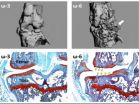(Press-News.org) SEATTLE, WA – Anterior Cruciate Ligament (ACL) reconstructions occur more than 200,000 times a year, but the type of material used to create a new ligament may determine how long you stay in the game, say researchers presenting their work today at the Annual Meeting of the American Orthopaedic Society of Sports Medicine (AOSSM).
"Our study results highlight that in a young athletic population, allografts (tissue harvested from a donor) fail more frequently than using autografts (tissue harvested from the patient)," said Craig R. Bottoni, MD, lead author from Tripler Army Medical Center in Honolulu, Hawaii. "After following the patients for 10 years, more than 80 percent of all grafts were intact and had maintained stability. However, those patients who had an allograft, failed at a rate more than three times higher than those reconstructed with an autograft. This study was also of only one type of allograft (Tibialis Posterior). Therefore, we can make a strong statement about that type and not necessarily extrapolate to other types of allografts, most notably those with bone, i.e. BTB or Achilles."
Bottoni and his team, followed 99 patients who had used either an autograft or allograft for their ACL reconstruction. All allografts were from a single tissue bank, aseptically processed and fresh frozen without terminal irradiation. Graft fixation was identical in all knees. All patients followed the same post-operative rehabilitation protocol. The primary outcome measures were graft integrity, subjective knee stability and functional status.
Eighty-seven of the patients were male with 95 individuals in active duty military. Both groups were similar in demographics and preoperative activity level. The mean and median age of both groups was identical
at 29 and 26, respectively. There were four (8.3%) autograft and 13 (26.5%) allograft failures which required revision reconstruction. In the remaining patients whose graft was intact, there was no difference in the mean SANE, Tegner, or IKDC scores.
"By better understanding why and how grafts fail in ACL reconstructions, we can increase the life span of these procedures and minimize future surgeries where feasible," said Bottoni.
INFORMATION:
The American Orthopaedic Society for Sports Medicine (AOSSM) is a world leader in sports medicine education, research, communication and fellowship, and includes national and international orthopaedic sports medicine leaders. The Society works closely with many other sports medicine specialists, including athletic trainers, physical therapists, family physicians, and others to improve the identification, prevention, treatment, and rehabilitation of sports injuries. AOSSM is also a founding partner of the STOP Sports Injuries campaign to prevent overuse and traumatic injuries in kids. For more information on AOSSM or the STOP Sports Injuries campaign, visit http://www.sportsmed.org or http://www.stopsportsinjuries.org
ACL reconstructions may last longer with autografts
2014-07-11
ELSE PRESS RELEASES FROM THIS DATE:
New study may identify risk factors for ACL re-injury
2014-07-11
SEATTLE, WA – Re-tearing a repaired knee Anterior Cruciate Ligament (ACL) happens all too frequently, however a recent study being presented today at the American Orthopaedic Society for Sports Medicine's (AOSSM) Annual Meeting suggests that identification and patient education regarding modifiable risk factors may minimize the chance of a future ACL tear.
"Our research suggests that a few risk factors such as, age, activity level and type of graft utilized may point to the possibility of re-injury," said lead author, Christopher C. Kaeding, MD of the Ohio State University. ...
Potent spider toxin 'electrocutes' German, not American, cockroaches
2014-07-11
Using spider toxins to study the proteins that let nerve cells send out electrical signals, Johns Hopkins researchers say they have stumbled upon a biological tactic that may offer a new way to protect crops from insect plagues in a safe and environmentally responsible way.
Their finding—that naturally occurring insect toxins can be lethal for one species and harmless for a closely related one—suggests that insecticides can be designed to target specific pests without harming beneficial species like bees. A summary of the research, led by Frank Bosmans, Ph.D., an assistant ...
Blame it on the astrocytes
2014-07-11
Rio de Janeiro, Brazil- In the brains of all vertebrates, information is transmitted through synapses, a mechanism that allows an electric or chemical signal to be passed from one brain cell to another. Chemical synapses, which are the most abundant type of synapse, can be either excitatory or inhibitory. Synapse formation is crucial for learning, memory, perception and cognition, and the balance between excitatory and inhibitory synapses critical for brain function. For instance, every time we learn something, the new information is transformed into memory through synaptic ...
Omega 3 fatty acids lessen severity of osteoarthritis in mice
2014-07-11
Mice consuming a supplement of omega 3 fatty acids had healthier joints than those fed diets high in saturated fats and omega 6 fatty acids, according to Duke Medicine researchers.
The findings, published in the Annals of the Rheumatic Diseases (10.1136/annrheumdis-2014-205601) on July 11, 2014, suggest that unhealthy dietary fats – not just obesity – may contribute to worsening osteoarthritis.
"Our results suggest that dietary factors play a more significant role than mechanical factors in the link between obesity and osteoarthritis," said Farshid Guilak, Ph.D., Laszlo ...
'Tailored' water -- the latest in lawn care
2014-07-11
In Santa Fe, Albuquerque, and other major cities in New Mexico, nearly every public golf course is now watered with treated municipal wastewater rather than precious potable water supplies. Across the U.S. Southwest as a whole, more than 40% of all golf courses receive treated effluent. Reusing the effluent increases the sustainability of golf courses.
Additionally, golf courses and homeowners alike fertilize their lawns during the growing season. The major nutrient in fertilizer is nitrate. A New Mexico State University turfgrass expert has a new vision for even more ...
Non-invasive test could be used to predict premature birth and delivery of small babies
2014-07-11
Testing for the presence of specific molecules present in the urine of pregnant women can give an indication in early pregnancy of whether a baby will be born premature or the fetus will suffer poor growth, according to research published in the open access journal BMC Medicine. Identifying these conditions early in pregnancy could potentially help reduce complications and manage any difficulties, although more work is needed before the findings can be translated to clinical settings.
Researchers from Imperial College London and the University of Crete analyzed the metabolites ...
Women under-represented in academic medicine
2014-07-11
Women are under-represented in academic medicine resulting in a waste of public investment due to loss of research talent. Writing in the July issue of the Journal of the Royal Society of Medicine, authors of an essay on women and academic medicine say that as a consequence of female under-representation, some areas of medicine are under-researched at a cost to patients and society. Discriminatory practices and unconscious bias, they say, continue to occur in academic medicine, despite a substantial fall in traditional discrepancies between men and women in medicine in ...
Heart health benefits of light drinking brought into question
2014-07-11
A reduction in alcohol consumption, even for light-to-moderate drinkers, could be linked to improved cardiovascular health, including a reduced risk of coronary heart disease, lower body mass index and blood pressure, according to new research published in The BMJ.
These latest findings challenge the results of previous observational studies which found that the consumption of light-to-moderate amounts of alcohol (12-25 units per week) may have a protective effect on cardiovascular health.
The research, led by the London School of Hygiene & Tropical Medicine with University ...
Injected vaccine could help eradicate polio
2014-07-11
Re-introducing a type of polio vaccine that fell out of favour in the 1960s could hasten eradication of the disease, according to new research.
The study, by Imperial College London and the Christian Medical College in Vellore, India, suggests that the injected polio vaccine (IPV), which is rarely used today in countries affected by polio, could provide better and longer lasting protection against infection if used in combination with the more commonly used live oral polio vaccine (OPV).
The findings are published today in The Lancet.
Vaccination protects an individual ...
The Lancet: World's most advanced dengue vaccine candidate shows promise in phase 3 trial
2014-07-11
The first dengue vaccine candidate (CYD-TDV) to reach phase 3 clinical testing has shown moderate protection (56%) against the disease in Asian children, according to new research published in The Lancet.
Dengue is a mosquito-borne disease that infects around 390 million people each year, of whom about 96 million suffer from symptomatic infection. WHO estimates that the global burden of dengue has risen 30-fold over the past 50 years, with over half of the world's population at risk of the disease.
There is no licensed vaccine available to treat or prevent dengue ...


